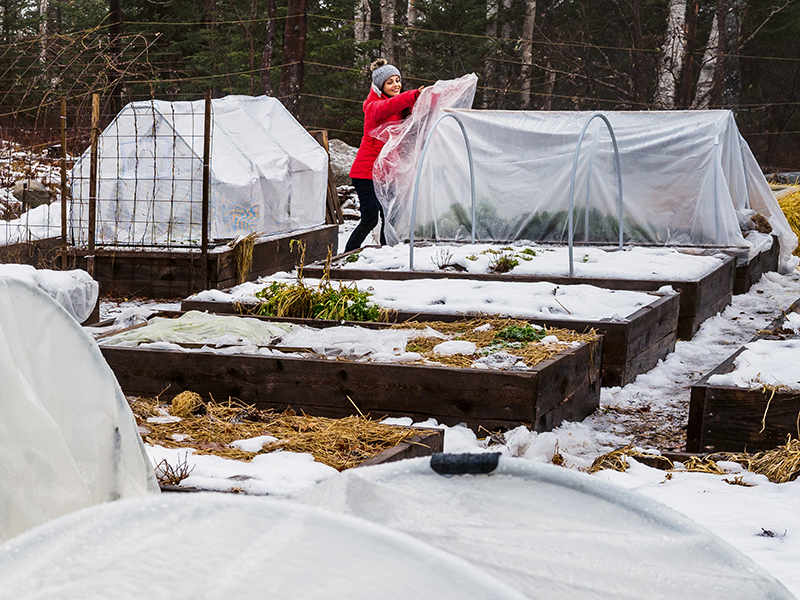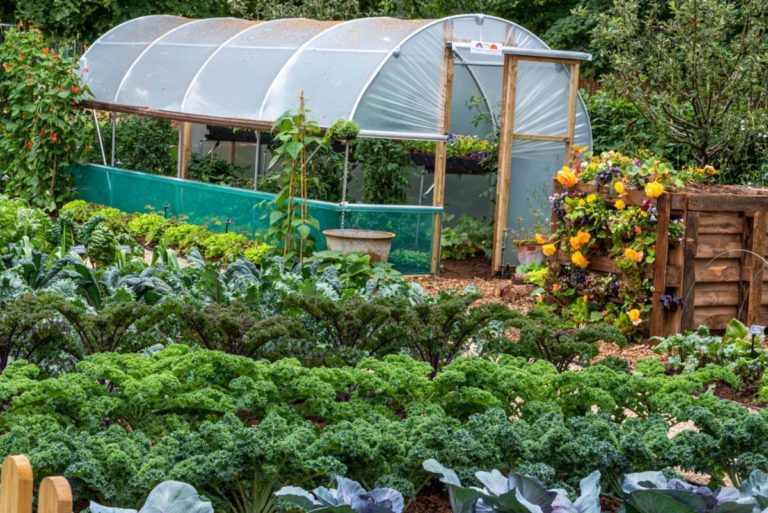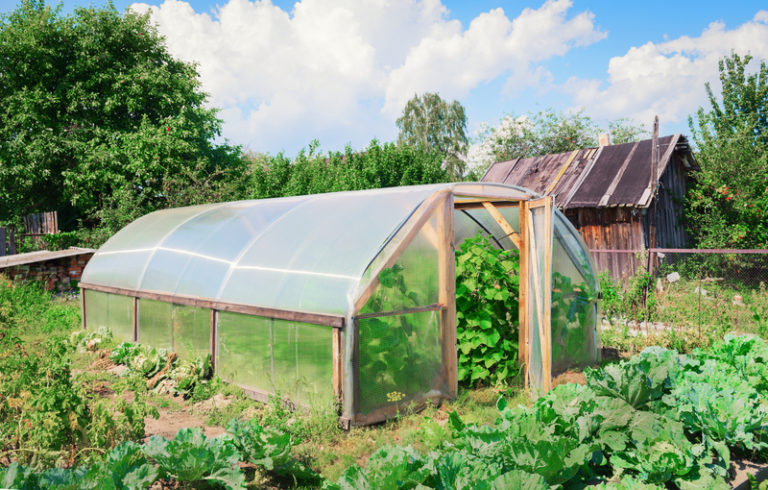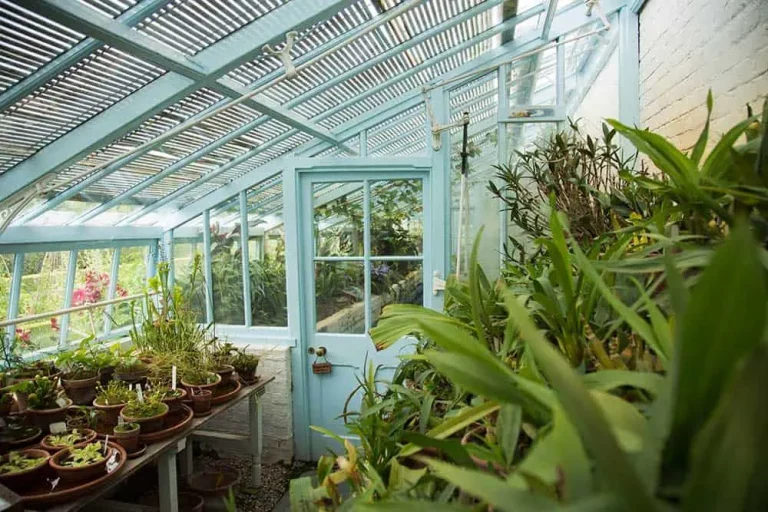As the seasons change and the weather cools, many gardeners think their gardens must come to an end.
But with the right techniques, you can extend your growing season well into the fall and even winter months!
From using cold-hardy vegetables and greens to protecting plants from frost and incorporating mulch and cover crops, there are numerous strategies for continuing to grow a vibrant and productive garden long after summer has ended.
By implementing these techniques, you can enjoy fresh produce all year round, while also supporting the health of your soil and local ecosystem.
Use row covers
Row covers are lightweight, porous fabrics that allow plants to breathe and receive sunlight while protecting them from frost and cold temperatures. They can be used to extend the growing season by shielding plants from harsh weather conditions.
These lightweight, porous fabrics allow your plants to breathe and receive sunlight while shielding them from frost and cold temperatures.
Unlike rigid hoops or cold frames, row covers can be easily installed and removed as needed, providing a flexible and versatile solution for year-round gardening.
Plus, they allow for better air circulation and can help prevent diseases and pests, resulting in healthier and more productive plants.
With row covers, you can enjoy a longer growing season and greater yield from your crops, giving you more control over your garden’s success.
Build a cold frame
A cold frame is a structure that covers the plants with a transparent material, allowing sunlight to enter and warm the inside environment. This can extend the growing season by providing a protected environment for plants to grow in.
Build a Cold Frame to Extend Your Growing Season
Are you looking for a way to extend your growing season and give your plants a head start on the next year’s harvest?
Consider building a cold frame!
A cold frame is a simple yet effective structure that covers your plants with a transparent material, allowing sunlight to enter and warm the inside environment.
This extension of the growing season can be especially beneficial for vegetables like broccoli, kale, and spinach that thrive in cooler temperatures.
With a cold frame, you can start seedlings early in the spring and continue to grow them throughout the fall, even in regions with harsh winters.
The transparent roof of the cold frame allows sunlight to enter and warm the inside environment, while the protective sides keep out wind and frost.
This results in a warmer and more stable microclimate for your plants, enabling them to grow stronger and healthier.
To build a cold frame, you will need a frame of wood or metal, a clear plastic or polycarbonate cover, and some hinges or clips to secure the cover.
You can also add ventilation openings to regulate the temperature and humidity inside the cold frame.
Once built, simply plant your seedlings or seeds inside the cold frame, and provide them with the necessary care and attention.
With a cold frame, you can enjoy an extended growing season and harvest a bountiful crop of delicious, nutritious vegetables.
Use a hoop house
A hoop house is a low-cost, simple structure that can be used to extend the growing season. It is essentially a greenhouse without walls, using plastic or polyethylene sheeting to trap heat and protect plants from cold temperatures.
If you’re looking to extend your growing season and give your plants a head start on the cold weather, consider using a hoop house!
This low-cost and simple structure is essentially a greenhouse without walls, using plastic or polyethylene sheeting to trap heat and protect your plants from the chill.
By providing a warm and sheltered environment, a hoop house can help you grow a wider variety of crops and get a longer harvest season.
Here’s how to build one
Start by setting up a series of metal or PVC hoops over the beds where you want to grow your plants.
These hoops should be spaced about 6-8 feet apart and should be high enough to allow for comfortable standing room.
Next, drape plastic or polyethylene sheeting over the hoops and secure it with clips or ropes.
Make sure the sheeting is tightly sealed around the edges to prevent heat from escaping.
To maximize the warmth inside the hoop house, use a black plastic sheeting, which will absorb the most sunlight and retain the heat.
You can also install a thermal blanket or bubble wrap on the inside of the structure to add extra insulation.
In addition to providing a warm environment, a hoop house can also protect your plants from pests and diseases by keeping them away from the elements.
By using a hoop house, you can extend the growing season and grow a wider variety of crops, ultimately increasing your harvest and giving you more food to enjoy!
Choose cold-hardy plants
Some plants, such as kale, spinach, and brassicas, are more resistant to frost and cold temperatures than others. By choosing these plants, you can extend your growing season into the fall and winter months.
Choosing cold-hardy plants is a great way to extend your growing season and enjoy fresh, delicious produce even in the coldest of winters.
These plants, such as kale, spinach, and brassicas, are genetically adapted to withstand frost and cold temperatures, making them ideal for growing in cooler climates.
When the weather turns chilly, these plants will continue to thrive, producing delicious and nutritious leaves, roots, and shoots that can be enjoyed in salads, soups, and side dishes.
Plus, since they are more resistant to frost and cold temperatures, you can enjoy a longer growing season and harvest these plants well into the fall and winter months.
So, whether you’re a seasoned gardener or just starting out, consider incorporating cold-hardy plants into your garden for a bountiful harvest all year round!
Use mulch
Mulch can help to insulate the soil, protecting the roots of plants from cold temperatures. This can extend the growing season by allowing plants to continue growing later into the year.
Using mulch in your garden can be a game-changer, especially in colder climates.
Mulch acts as an insulator, keeping the soil warm and protecting plant roots from harsh cold temperatures.
This extension of the growing season allows gardeners to plant a wider variety of crops, as well as give existing plants more time to mature before the onset of winter.
Mulch can help to conserve moisture in the soil, reducing the need for frequent watering.
The ideal thickness for mulch varies depending on the type of plant and climate, but a general rule of thumb is to apply a layer of 2-4 inches.
By implementing mulch into your gardening routine, you can enjoy a longer growing season, healthier plants, and reduced water consumption.
Use a cold-weather irrigation system
By using a drip irrigation system or soaker hose, you can water your plants without having to physically touch them, which can be especially useful during the cold winter months.
Using a cold-weather irrigation system, such as a drip irrigation system or soaker hose, is a smart and efficient way to water your plants during the cold winter months.
These systems deliver water directly to the roots of the plants, reducing evaporation and runoff, and allowing the water to penetrate the soil more effectively.
This method of irrigation is especially useful during the winter months when the soil is colder and the plants are dormant, as it allows you to water your plants without having to physically touch them, protecting them from potential damage.
By using a cold-weather irrigation system, you can ensure that your plants receive the necessary moisture they need to survive the winter, all while keeping them safe from harm.
These systems are often equipped with features such as frost protection and anti-freeze solutions, which can help to protect your plants from extreme cold temperatures and frost damage.
Overall, using a cold-weather irrigation system is a simple yet effective way to keep your plants healthy and thriving during the winter months.
Grow plants under lights
If you have a indoor space, such as a greenhouse or sunroom, you can grow plants under artificial lights during the winter months. This can extend the growing season by providing a warm, light-filled environment for plants to grow in.
Growing plants under lights can be a game-changer for gardeners who want to extend their growing season.
By using artificial lights, you can create a warm and light-filled environment for your plants to thrive in, even during the coldest months of the year.
This is especially useful for gardeners who have indoor spaces, such as greenhouses or sunrooms, where the lights can be positioned to provide optimal growing conditions.
To get started, you’ll need to choose the right type of lighting for your plants.
LED grow lights are a popular choice, as they are energy-efficient and produce minimal heat.
These lights are designed to simulate the natural light spectrum, providing the necessary spectrum for photosynthesis and healthy plant growth.
You’ll also need to ensure that the lights are positioned at the correct distance and angle to provide the appropriate amount of light for your plants.
You’ll need to consider the type of plants you want to grow, as some plants may require more light than others.
For example, leafy greens like lettuce and kale are relatively low-light plants, while flowers and fruiting plants like tomatoes and peppers require more light.
By carefully selecting the right lighting and plant combination, you can create a thriving indoor garden that produces delicious and nutritious fruits and vegetables all year round.
Use a hotbed
A hotbed is a raised bed that is covered with a transparent material, such as plastic or glass, to trap heat and warm the inside environment. This can extend the growing season by providing a warm environment for plants to grow in, even during the coldest months of the year.
Using a hotbed is a fantastic way to extend your growing season and provide a warm environment for your plants to thrive in, even during the coldest months of the year.
A hotbed is a raised bed that is covered with a transparent material, such as plastic or glass, which traps heat and warmth, creating a microclimate that is ideal for growing a variety of plants.
To set up a hotbed, start by preparing a raised bed with a depth of at least 6 inches and a length and width that suits your needs.
Next, cover the bed with a transparent material, such as plastic or glass, and secure it with a frame or hoops.
You can also add a layer of insulating material, such as straw or bubble wrap, to help retain heat.
Once your hotbed is set up, you can start planting a variety of crops, such as lettuce, spinach, and herbs, that prefer cooler temperatures and longer growing seasons.
These crops will benefit from the warmer environment provided by the hotbed, and you can enjoy a bountiful harvest even during the coldest months of the year.
You can use the hotbed to grow plants in areas with short growing seasons, such as northern climates, and enjoy a longer growing season.
Overall, using a hotbed is a simple and effective way to extend your growing season and provide a warm environment for your plants to thrive in.
With proper care and attention, you can enjoy a bountiful harvest year-round, no matter the weather.
Want More? Dive Deeper Here!
Hey there! If you’re the type who loves going down the rabbit hole of information (like we do), you’re in the right spot. We’ve pulled together some cool reads and resources that dive a bit deeper into the stuff we chat about on our site. Whether you’re just killing time or super into the topic, these picks might just be what you’re looking for. Happy reading!
- Stretch Your Growing Season Into the Fall With Season Extension Techniques and Cold Hardy Vegetables – It Grows in Alaska
- Extending the Garden Season with Season Extension | Horticulture, Landscape, and Environmental Systems | Nebraska
- Extending the Garden Season – Wisconsin Horticulture
- Extending the growing season: start early, end later | UMN Extension






